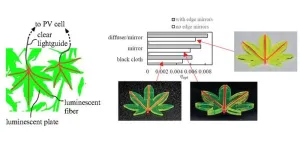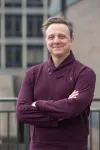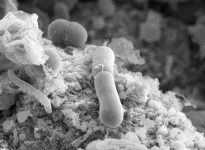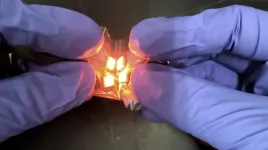(Press-News.org) Since its invention in the 1970s, the luminescent solar concentrator (LSC) has aimed to enhance solar energy capture by using luminescent materials to convert and concentrate sunlight onto photovoltaic (PV) cells. Unlike traditional concentrators that rely on mirrors and lenses, LSCs can harvest diffuse light and have been used in applications such as building-integrated photovoltaics, where their semitransparent and colorful nature offers aesthetic benefits. However, scaling up LSCs to cover large areas has been challenging due to issues like self-absorption of photoluminescent (PL) photons within the waveguide. Researchers at Ritsumeikan University (Japan) have proposed an innovative "leaf LSC" model that promises to overcome such limitations by enhancing the collection and transfer of light to photovoltaic cells.
The leaf LSC design addresses the scalability problem by using smaller, interconnected luminescent components that function like leaves on a tree. As reported in the Journal of Photonics for Energy (JPE), this innovative setup involves placing luminescent plates around a central luminescent fiber, with the plates’ sides facing the fiber. This arrangement allows incident photons to be converted into PL photons by the plates, which then travel through the fiber and are collected at its tip by a PV cell. To enhance efficiency, clear lightguides connect multiple fibers to a single PV cell, effectively increasing the incident area of the LSC while reducing photon losses due to self-absorption and scattering.
This modular approach to LSC design offers several advantages. By reducing the lateral size of individual modules, researchers have found that the efficiency of photon collection improves. For instance, reducing the side length of a square leaf LSC from 50 mm to 10 mm increased photon collection efficiency significantly. The modular design also allows for easy replacement of damaged units and integration of advanced luminescent materials as they become available.
Further enhancing the system’s efficiency, researchers have incorporated techniques from traditional planar LSCs, such as edge mirrors and tandem structures, into the leaf LSC design. Their experiments demonstrated that the optical efficiency of these leaf-like structures can be calculated analytically based on the spectrum and intensity of incident light, using a single-spot excitation technique.
According to JPE Editor-in-Chief Sean Shaheen, professor of engineering and physics at University of Colorado Boulder, and fellow of the Renewable and Sustainable Energy Institute, “These findings demonstrate a creative approach that advances the concept of luminescent solar concentrators to effectively guide sunlight toward adjacent photovoltaic devices. By combining scalable, bio-inspired designs with enhancements in optical engineering, the authors have increased the efficiency of their devices toward what is needed for practical use."
Optimizing photon collection in LSCs may light the way for more flexible and scalable solar energy solutions. This approach to energy harvesting could revolutionize the application of solar concentrators, making them more efficient and adaptable for various uses, from large-scale installations to building-integrated systems. As the technology advances, it holds the promise of significantly enhancing the performance of solar energy systems and contributing to more sustainable energy solutions.
For details, see the Gold Open Access article, “Enhanced photon collection in leaf-inspired luminescent solar concentrators,” J. Photon. Energ. 14(3), 035501 (2024) doi 10.1117/1.JPE.14.035501.
END
Leaf-like solar concentrators promise major boost in solar efficiency
Leaf-like solar concentrators offer a promising solution for more scalable and effective solar energy systems
2024-08-15
ELSE PRESS RELEASES FROM THIS DATE:
UTEP awarded $2.5 M NIH grant to study nicotine dependence in women
2024-08-15
EL PASO, Texas (Aug. 15, 2024) — Researchers at The University of Texas at El Paso will undertake a new study that could lead to improved nicotine cessation treatments for women. The work is supported by a new $2.5 million grant from the National Institute on Drug Abuse (NIDA), part of the National Institutes of Health (NIH).
Principal investigator Laura O'Dell, Ph.D., a professor in the Department of Psychology at UTEP, will lead the multidisciplinary study into how stress produced by nicotine withdrawal is intensified by variations in ovarian hormones in women.
The study ...
DOE announces $10 million to support climate resilience centers across America
2024-08-15
WASHINGTON, D.C. – To support vulnerable communities responding to continued and extreme climate effects, the Department of Energy (DOE) today announced $10 million in funding for innovative Climate Resilience Centers (CRCs) in 10 different states. University-led research teams will leverage the world class modeling, data and research capabilities from DOE national laboratories customized for their local regions with a focus on climate prediction of weather hazard risks to better prepare communities. The CRCs are part of the Biden-Harris Administration’s Justice40 Initiative and are designed to ensure that all Americans are benefitting from scientific research.
“Every ...
Science in Space to Cure Disease on Earth—the International Space Station National Lab and NASA announce new funding opportunity
2024-08-15
KENNEDY SPACE CENTER (FL), August 15, 2024—The International Space Station (ISS) National Laboratory is collaborating with NASA on a solicitation for space-based research addressing some of the most significant diseases of our time—such as cancer, cardiovascular disease, and neurodegenerative disease. ISS National Lab Research Announcement (NLRA) 2024-09: Igniting Innovation: Science in Space to Cure Disease on Earth, released in partnership with NASA’s Biological and Physical Sciences division, is aimed at overcoming challenges hindering progress in disease prevention, diagnosis, and treatment. This NLRA ...
YALE NEWS: Sick days: Assessing the economic costs of long COVID
2024-08-15
A new Yale study finds that the effects of long COVID have caused many Americans to miss extensive work time, and that 14% of study participants reported not returning to work in the months after their infection.
The findings, published recently in PLOS One, suggest that long COVID may have affected millions of Americans and generated steep economic costs, highlighting the need for policies to support those with the condition, researchers said.
The study drew on a long-term survey of individuals who contracted COVID-19 — dubbed Innovative ...
Equity weighting increases the social cost of carbon, warrants careful dialogue
2024-08-15
In a Policy Forum, Brian Prest and colleagues discuss how new regulatory guidelines from the U.S. Office of Management and Budget (OMB), known as Circular A-4, could impact the social cost of carbon (SCC). The new equity weighting approach recommended by the OMB, they say, leads to a dramatic increase in SCC estimates, and thus requires careful dialogue and discussion. The social cost of carbon is an estimate of the economic damage caused by emitting an additional ton of carbon dioxide into the atmosphere. It helps guide decisions about balancing the costs of reducing emissions with the benefits of mitigating climate change. Traditionally, ...
Chicxulub impactor was a carbonaceous-type asteroid from beyond Jupiter
2024-08-15
Scientists have pinpointed the origin and composition of the asteroid that caused the mass extinction 66 million years ago, revealing it was a rare carbonaceous asteroid from beyond Jupiter, according to a new study. The findings help resolve long-standing debates about the nature of Chicxulub impactor, reshaping our understanding of Earth's history and the extraterrestrial rocks that have collided with it. Earth has experienced several mass extinction events. The most recent event occurred 66 million years ago at the boundary between the Cretaceous and Paleogene eras (K-Pg boundary) and resulted in the loss of roughly 60% of the planet’s species, including non-avian dinosaurs. ...
A role for a newly identified brain activity during sleep-dependent memory consolidation
2024-08-15
A newly identified activity in the brain that occurs while we sleep – a barrage of action potentials, or a BARR – plays a crucial role in rebalancing the hippocampal neural network during memory consolidation. The findings offer fresh insights into how our brains preserve memories while maintaining stability, as we slumber. Memory consolidation – a process that stabilizes and strengthens our recent experiences into long-term memories – occurs when we sleep. During the non-rapid eye movement (NREM) phase of sleep, ...
Scientists discover superbug's rapid path to antibiotic resistance
2024-08-15
Researchers at the University of Sheffield have discovered how a hospital superbug Clostridioides difficile (C.diff) can rapidly evolve resistance to vancomycin, the frontline drug used in the UK
Scientists found that in less than two months the bacteria could develop resistance to 32 times the initial antibiotic concentration
C.diff, a type of bacteria which often affects people who have been taking antibiotics, has been identified by the World Health Organisation as one of the top global public health threats, and is responsible ...
New technique prints metal oxide thin film circuits at room temperature
2024-08-15
Researchers have demonstrated a technique for printing thin metal oxide films at room temperature, and have used the technique to create transparent, flexible circuits that are both robust and able to function at high temperatures.
“Creating metal oxides that are useful for electronics has traditionally required making use of specialized equipment that is slow, expensive, and operates at high temperatures,” says Michael Dickey, co-corresponding author of a paper on the work and the Camille and Henry Dreyfus Professor of Chemical and Biomolecular Engineering at North Carolina State University. “We wanted ...
Sleep resets neurons for new memories the next day
2024-08-15
ITHACA, N.Y. – While everyone knows that a good night’s sleep restores energy, a new Cornell University study finds it resets another vital function: memory.
Learning or experiencing new things activates neurons in the hippocampus, a region of the brain vital for memory. Later, while we sleep, those same neurons repeat the same pattern of activity, which is how the brain consolidates those memories that are then stored in a large area called the cortex. But how is it that we can keep learning new things for a lifetime without using up all of our neurons?
A new study, “A Hippocampal Circuit Mechanism ...
LAST 30 PRESS RELEASES:
Myeloma: How AI is redrawing the map of cancer care
Manhattan E. Charurat, Ph.D., MHS invested as the Homer and Martha Gudelsky Distinguished Professor in Medicine at the University of Maryland School of Medicine
Insilico Medicine’s Pharma.AI Q4 Winter Launch Recap: Revolutionizing drug discovery with cutting-edge AI innovations, accelerating the path to pharmaceutical superintelligence
Nanoplastics have diet-dependent impacts on digestive system health
Brain neuron death occurs throughout life and increases with age, a natural human protein drug may halt neuron death in Alzheimer’s disease
SPIE and CLP announce the recipients of the 2025 Advanced Photonics Young Innovator Award
Lessons from the Caldor Fire’s Christmas Valley ‘Miracle’
Ant societies rose by trading individual protection for collective power
Research reveals how ancient viral DNA shapes early embryonic development
A molecular gatekeeper that controls protein synthesis
New ‘cloaking device’ concept to shield sensitive tech from magnetic fields
Researchers show impact of mountain building and climate change on alpine biodiversity
Study models the transition from Neanderthals to modern humans in Europe
University of Phoenix College of Doctoral Studies releases white paper on AI-driven skilling to reduce burnout and restore worker autonomy
AIs fail at the game of visual “telephone”
The levers for a sustainable food system
Potential changes in US homelessness by ending federal support for housing first programs
Vulnerability of large language models to prompt injection when providing medical advice
Researchers develop new system for high-energy-density, long-life, multi-electron transfer bromine-based flow batteries
Ending federal support for housing first programs could increase U.S. homelessness by 5% in one year, new JAMA study finds
New research uncovers molecular ‘safety switch’ shielding cancers from immune attack
Bacteria resisting viral infection can still sink carbon to ocean floor
Younger biological age may increase depression risk in older women during COVID-19
Bharat Innovates 2026 National Basecamp Showcases India’s Most Promising Deep-Tech Ventures
Here’s what determines whether your income level rises or falls
SCIE indexation achievement: Celebrate with Space: Science & Technology
Children’s Hospital Colorado performs region’s first pediatric heart and liver dual organ transplant
Australian team discover why quantum computers have memory problems over time
What determines the fate of a T cell?
Candida auris: genetic process revealed which could be treatment target for deadly fungal disease
[Press-News.org] Leaf-like solar concentrators promise major boost in solar efficiencyLeaf-like solar concentrators offer a promising solution for more scalable and effective solar energy systems





